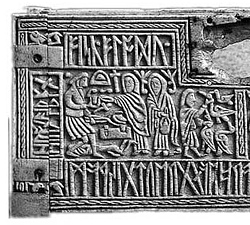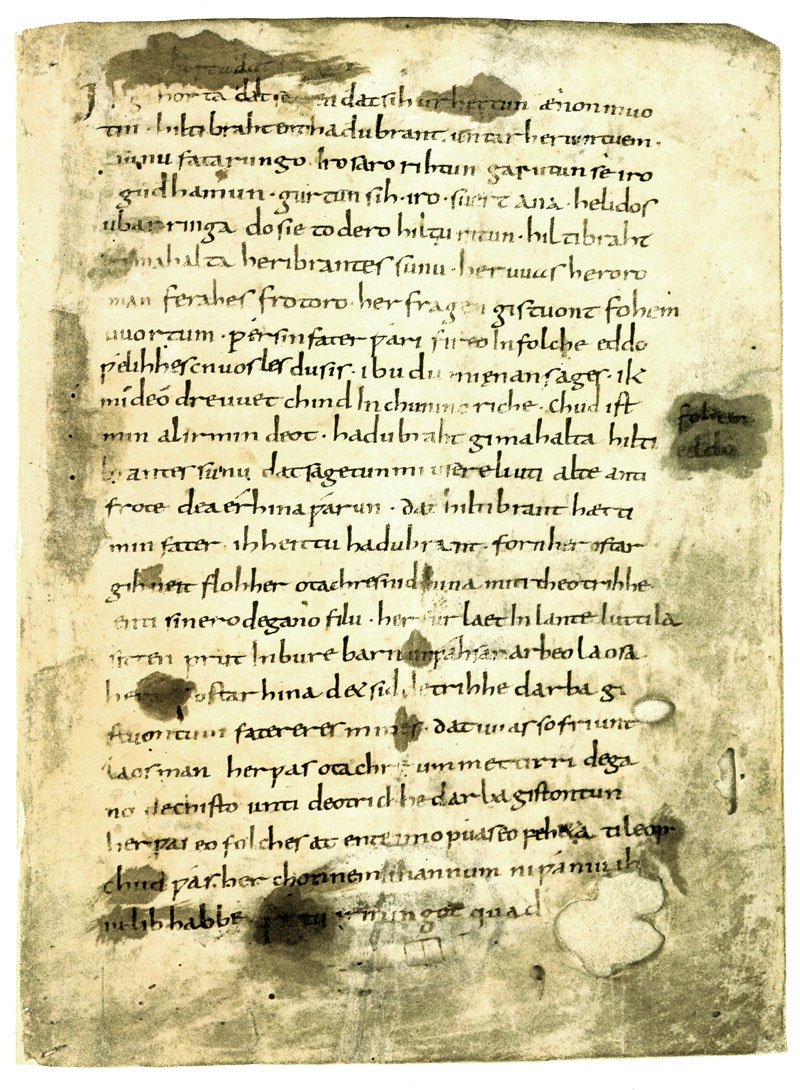|
Old English
Old English ( or , or ), or Anglo-Saxon, is the earliest recorded form of the English language, spoken in England and southern and eastern Scotland in the Early Middle Ages. It developed from the languages brought to Great Britain by Anglo-Saxon settlers in the mid-5th century, and the first Old English literature dates from the mid-7th century. After the Norman Conquest of 1066, English was replaced for several centuries by Anglo-Norman language, Anglo-Norman (a langues d'oïl, type of French) as the language of the upper classes. This is regarded as marking the end of the Old English era, since during the subsequent period the English language was heavily influenced by Anglo-Norman, developing into what is now known as Middle English in England and Early Scots in Scotland. Old English developed from a set of Anglo-Frisian or Ingvaeonic dialects originally spoken by Germanic tribes traditionally known as the Angles (tribe), Angles, Saxons and Jutes. As the Germanic settlers ... [...More Info...] [...Related Items...] OR: [Wikipedia] [Google] [Baidu] |
Wynn
Wynn or wyn (; also spelled wen, win, ƿynn, ƿyn, ƿen, and ƿin) is a letter of the Old English Latin alphabet, Old English alphabet, where it is used to represent the sound . History The letter "W" While the earliest Old English texts represent this phoneme with the Digraph (orthography), digraph , scribes soon borrowed the runes, rune ''wynn'' for this purpose. It remained a standard letter throughout the Anglo-Saxon era, eventually falling out of use during the Middle English period, circa 1300. In post-wynn texts, it was sometimes replaced with but often replaced with a ligature form of , which the modern letter developed from. Meaning The denotation of the rune is ":wikt:joy, joy, :wikt:bliss, bliss", known from the Anglo-Saxon rune poems: Miscellaneous It is not continued in the Younger Futhark, but in the Gothic alphabet, the letter ''w'' is called , allowing a Proto-Germanic language, Proto-Germanic reconstruction of the rune's name as ''*wunjô'' " ... [...More Info...] [...Related Items...] OR: [Wikipedia] [Google] [Baidu] |
Vend (letter)
Vend (Ꝩ, ꝩ) is a letter of Old Norse. It was used to represent the sounds , , and . It was related to and probably derived from the Old English letter Wynn of the Runic alphabet (ᚹ) and later the Latin alphabet The Latin alphabet, also known as the Roman alphabet, is the collection of letters originally used by the Ancient Rome, ancient Romans to write the Latin language. Largely unaltered except several letters splitting—i.e. from , and from � ... (Ƿ ƿ), except that the bowl was open on the top, not being connected to the stem, which made it somewhat resemble a letter Y. It was eventually replaced with v or u for most writings. Vend in Unicode and HTML entities The upper and lowercase Vend were standardized in April 2008 as part of the Latin Extended-D block of Unicode 5.1 References Ꝩ Palaeographic letters Latin-script letters Runology {{Latin-alphabet-stub ... [...More Info...] [...Related Items...] OR: [Wikipedia] [Google] [Baidu] |
Futhorc
Anglo-Saxon runes or Anglo-Frisian runes are runes that were used by the Anglo-Saxons and Medieval Frisians (collectively called Anglo-Frisians) as an alphabet in their native writing system, recording both Old English and Old Frisian (, ᚱᚢᚾᚪ, "rune"). Today, the characters are known collectively as the futhorc (ᚠᚢᚦᚩᚱᚳ, ''fuþorc'') from the sound values of the first six runes. The futhorc was a development from the older co-Germanic 24-character runic alphabet, known today as Elder Futhark, expanding to 28 characters in its older form and up to 34 characters in its younger form. In contemporary Scandinavia, the Elder Futhark developed into a shorter 16-character alphabet, today simply called Younger Futhark. Use of the Anglo-Frisian runes is likely to have started in the 5th century onward and they continued to see use into the High Middle Ages. They were later accompanied and eventually overtaken by the Old English Latin alphabet introduced to Anglo-Sax ... [...More Info...] [...Related Items...] OR: [Wikipedia] [Google] [Baidu] |
Old English Latin Alphabet
The Old English Latin alphabet generally consisted of about 24 letters, and was used for writing Old English from the 8th to the 12th centuries. Of these letters, most were directly adopted from the Latin alphabet, two were modified Latin letters ( Æ, Ð), and two developed from the runic alphabet (Wynn, Ƿ, Thorn (letter), Þ). The letters Q and Z were essentially left unused outside of foreign names from Latin and Greek. The letter J had not yet come into use. The letter K was used by some writers but not by others. W gained usage in late Old English under Norman Conquest, Norman influence, as seen towards the end of the Peterborough Chronicle manuscript, though in this period W was still a ligature and not a full-fledged letter. The manuscripts , , and differ in how they arrange the non-standard Old English letters (Harley has Ƿ–ЖƖÞ, Stowe has Ƿ–ЖÞ, Titus has Ƿ–Þ–Ð), but all three manuscripts place them after the standard Latin letters. Hi ... [...More Info...] [...Related Items...] OR: [Wikipedia] [Google] [Baidu] |
Latin Script
The Latin script, also known as the Roman script, is a writing system based on the letters of the classical Latin alphabet, derived from a form of the Greek alphabet which was in use in the ancient Greek city of Cumae in Magna Graecia. The Greek alphabet was altered by the Etruscan civilization, Etruscans, and subsequently their alphabet was altered by the Ancient Romans. Several Latin-script alphabets exist, which differ in graphemes, collation and phonetic values from the classical Latin alphabet. The Latin script is the basis of the International Phonetic Alphabet (IPA), and the 26 most widespread letters are the letters contained in the ISO basic Latin alphabet, which are the same letters as the English alphabet. Latin script is the basis for the largest number of alphabets of any writing system and is the List of writing systems by adoption, most widely adopted writing system in the world. Latin script is used as the standard method of writing the languages of Western and ... [...More Info...] [...Related Items...] OR: [Wikipedia] [Google] [Baidu] |
English Alphabet
Modern English is written with a Latin-script alphabet consisting of 26 Letter (alphabet), letters, with each having both uppercase and lowercase forms. The word ''alphabet'' is a Compound (linguistics), compound of ''alpha'' and ''beta'', the names of the first two letters in the Greek alphabet. The earliest Old English writing during the 5th century used a runic alphabet known as the Anglo-Saxon futhorc, futhorc. The Old English Latin alphabet was adopted from the 7th century onward—and over the following centuries, various letters entered and fell out of use. By the 16th century, the present set of 26 letters had largely stabilised: There are 5 vowel letters and 19 consonant letters—as well as Y and W, which may function as either type. Written English has a large number of Digraph (orthography), digraphs, such as , , , , and . Diacritics are generally not used to write native English words, which is unusual among orthographies used to write the languages of Eu ... [...More Info...] [...Related Items...] OR: [Wikipedia] [Google] [Baidu] |
Runic Letter Wunjo
Runes are the Letter (alphabet), letters in a set of related alphabets, known as runic rows, runic alphabets or futharks (also, see ''#Futharks, futhark'' vs ''#Runic alphabets, runic alphabet''), native to the Germanic peoples. Runes were primarily used to represent a sound value (a phoneme) but they were also used to represent the concepts after which they are named (ideographic runes). Runology is the academic study of the runic alphabets, runic inscriptions, runestones, and their history. Runology forms a specialised branch of Germanic philology. The earliest secure runic inscriptions date from at latest AD 150, with a possible earlier inscription dating to AD 50 and Tacitus's possible description of rune use from around AD 98. The Svingerud Runestone dates from between AD 1 and 250. Runes were generally replaced by the Latin alphabet as the cultures that had used runes underwent Christianisation, by approximately AD 700 in central Europe and 1100 in northern Europe. Ho ... [...More Info...] [...Related Items...] OR: [Wikipedia] [Google] [Baidu] |
Hildebrandslied2
The ''Hildebrandslied'' (; ''Lay'' or ''Song of Hildebrand'') is a heroic lay written in Old High German alliterative verse. It is the earliest poem, poetic text in German, and it tells of the tragic encounter in battle between a father (Hildebrand) and a son (Hadubrand) who does not recognize him. It is the only surviving example in German of a genre which must have been important in the oral literature of the Germanic tribes. The text was written in the 830s on two spare leaves on the outside of a religious codex in the Fulda monastery, monastery of Fulda. The two scribes were copying from an unknown older original, which itself must ultimately have derived from oral tradition. The story of Hildebrand and Hadubrand almost certainly goes back to 7th- or 8th-century Lombardy and is set against the background of the historical conflict between Theodoric and Odoacer in 5th-century Italy, which became a major subject for Germanic heroic legend. The fundamental story of the father and ... [...More Info...] [...Related Items...] OR: [Wikipedia] [Google] [Baidu] |
Thorn (letter)
Thorn or þorn (Þ, þ) is a letter in the Old English Latin alphabet, Old English, Old Norse alphabet, Old Norse, Old Swedish and modern Icelandic orthography, Icelandic alphabets, as well as modern transliterations of the Gothic language, Gothic alphabet, Middle Scots, and some dialects of Middle English. It was also used in Middle Ages, medieval Scandinavia but was later replaced with the Digraph (orthography), digraph ''Th (digraph), th,'' except in Iceland, where it survives. The letter originated from the runic alphabet, rune in the Elder Futhark and was called ''thorn'' in the Anglo-Saxon and ''thorn'' or ''Jötunn, thurs'' in the Scandinavian rune poems. It is similar in appearance to the archaic Greek letter Sho (letter), sho (ϸ), although the two are historically unrelated. The only language in which þ is currently in use is Icelandic language, Icelandic. It represented a voiceless dental fricative or its voiced dental fricative, voiced counterpart . However, in mo ... [...More Info...] [...Related Items...] OR: [Wikipedia] [Google] [Baidu] |
Runes
Runes are the Letter (alphabet), letters in a set of related alphabets, known as runic rows, runic alphabets or futharks (also, see ''#Futharks, futhark'' vs ''#Runic alphabets, runic alphabet''), native to the Germanic peoples. Runes were primarily used to represent a sound value (a phoneme) but they were also used to represent the concepts after which they are named (ideographic runes). Runology is the academic study of the runic alphabets, runic inscriptions, runestones, and their history. Runology forms a specialised branch of Germanic philology. The earliest secure runic inscriptions date from at latest AD 150, with a possible earlier inscription dating to AD 50 and Tacitus's possible description of rune use from around AD 98. The Svingerud Runestone dates from between AD 1 and 250. Runes were generally replaced by the Latin alphabet as the cultures that had used runes underwent Christianisation, by approximately AD 700 in central Europe and 1100 in northern Europe. Ho ... [...More Info...] [...Related Items...] OR: [Wikipedia] [Google] [Baidu] |




